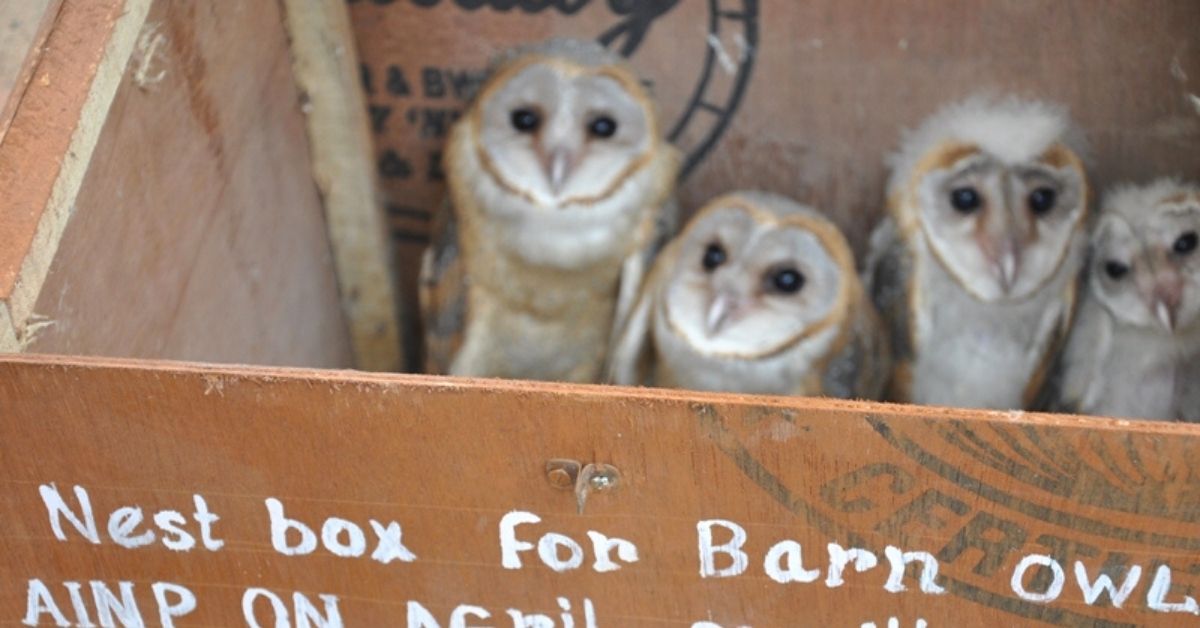Scientist’s Pesticide-Free Solution For an Assam District’s Rat Menace is Brilliant
For the past ten years, ornithologist Prabal Saikia has been working as a chief scientist at the Regional Agricultural Research Station (RARS) of the Assam Agricultural University. Here’s his unique solution to fighting rat menace in the region

On a quiet November evening in Assam, a barn owl awaits the darkness to creep in before flying out of its nest. As time suits, the nocturnal bird then swoops down stealthily on one of the rice fields in Lakhimpur village, where it preys on a rat and returns with its hunt.
“On average, an owl family, which includes the pair and three owlets, consume six rats,” says ornithologist and chief scientist Prabal Saikia, who works at the Regional Agricultural Research Station (RARS) of the Assam Agricultural University.
Prabal says November is the season when owls breed, the time of the year coinciding with the ripening of rice grains in the fields that attract rats who feed on the grains.
In the North-East state of Assam, scientists and farmers are working closely to help farmers keep the rodents at bay using natural methods by avoiding the use of pesticides and increasing the owl population. “Owls are natural enemies of rodents, and this nature’s cycle helps to balance the ecosystem. It, in turn, helps farmers from damaging their crops,” he says.

Barn owls are scientifically called Tyto alba, derived from the Greek words tyto, which means owl and alba is the Latin word for white. It is commonly known as a night owl, monkey-faced owl, ghost owl and white owl.
Pest Control Sans Pesticides
“There are no known figures about the population of barn owls in the region, but the declining tree cavities due to deforestation and other loss of habitat leads us to assume their populations may be declining. Hence, it becomes crucial to conserve and protect the species,” Prabal says.
He adds that he forayed into barn owl conservation after learning about one farmer Dilip Konwar from Kadam Gohain gaon, Lakhimpur, who had barn owls on his shop’s roof. “It was in 2009 that I heard noises coming from the roof of my shop. I climbed on a ladder to find a family of barn owls surrounded by bones of rats, lizards and other small animals,” Dilip says.
Prabal checked the nesting and thus began the experiment. In 2012, he conceived a nest box made from soft plywood. “The entry hole of the box was 6×6 inches in diameter with effective ventilation on two sides and adequate space to accommodate owlets and the birds who could stretch their wings,” he says.
The small experiment has helped Prabal achieve over 90 per cent success rate in breeding the barn owls against the natural roosting percentage of 60 per cent. Moreover, it has helped farmers control rodents up to 80 per cent, he claims.
“I installed two boxes at Dilip’s house who also ran a rice mill adjacent to the paddy farm. More such artificial nests were shared among farmers in the next few months before the breeding season began,” he explains.
The scientist conducted a pilot study in Kadam Kakoi village between 2009 and 2017. “We covered 120 farmers covering about 75 acres of farmland,” he says.
Later on, he installed the nest boxes in Lakhimpur Jorhat, Dhemaji and Sivasagar districts under the ICAR supported research project, AINP on vertebrae pest management, RARS and North Lakhimpur Assam Agricultural University.
Prabal installed 60 nest boxes across the districts. “We fixed 15 boxes in each district which displayed impressive results,” he says.

The scientist says the breeding success rate was 100 per cent in the boxes while in natural surroundings checked in 36 roosting sites it was 66 per cent.
“The nests had 45 per cent occupancy with 25 boxes occupied by the barn owl. Each nest box gave birth to an average of 6-7 owlets resulting in a fourfold increase in the owl population compared to those observed in natural nests,” Prabal says.
He says the increase in the number of nest boxes improved the owl population density and coincided with a drop in damage to paddy fields. “We found that the losses caused by field rats dropped from 12 per cent to 2 per cent,” he adds.
Dilip Konwar adds, “I saw a significant drop in the number of rodents in my mill. My farm and mill collectively saw a reduction of rats by over 60 per cent.”
Apart from him, other farmers also benefited from the initiative. “Farmers from the entire village reaped benefits. We have farms spread in about 500 acres, and many farmers reported a decrease in damages incurred by the rodents,” he says.
Conserving Families of Owls
Principal at the Government DB model college of science at Darrang district, Lakhi Prasad Hazarika, says, “Barn owls are extremely rare to find in the region and play a natural and significant role in balancing the food chain of the ecosystem.”
Describing his recent observations, Lakhi says, “In 2021 and 2022, I observed three owlets and parents consuming about 600 field rats in two months. I found these numbers by the headcount of the skulls in their nest.”
Lakhi adds that his observations about another pair a few years ago revealed 1,270 rat skulls by a family of seven owls during the harvest season alone. “A family consuming such heavy amounts of rats shows they play a crucial role in keeping the rat population under check,” he says.

He adds that parent owls bring the hunted rats to feed the young ones. “The owls spit out the bones, teeth and other indigestible parts of the animal which are then retrieved and studied. About eight rats feed on one farm, and a pair of owls can cover up to a radius of 2 sq km, equivalent to 500 acres of land. So, we can comfortably conclude that a pair of owls can save a village from rodents,” he shares.
However, recently Lakhi found three owlets dead due to poisoning. “Many farmers in the area use rodent killers on their farms. This kills the rats but also affects the flora, fauna and biodiversity in the vicinity. I assume the owlets died after consuming the poison-laced rats,” he says.
Prabal says besides such threats, the owls also face challenges of habitat loss. “Less than 50 per cent of our nest boxes were found to be occupied by barn owls. They were primarily built for them but saw fewer dwellings. The remaining were nested by spotted owls, Mynas and other birds. It indicates the shortage of nesting sites in the region,” he says.
Another challenge is creating awareness among the farmers. “The farmers are unaware about the ecological repercussions of using the poison to control rodents and opting for an environmentally friendly way of using the nest boxes. They have to be convinced and pushed to explain the natural benefits of housing the barn owls,” he says.
But for now, Prabal is satisfied with his success and hopes to help the farmers in the region keep the rodent population under control while conserving the barn owl species.
Edited by Yoshita Rao
If you found our stories insightful, informative, or even just enjoyable, we invite you to consider making a voluntary payment to support the work we do at The Better India. Your contribution helps us continue producing quality content that educates, inspires, and drives positive change.
Choose one of the payment options below for your contribution-
By paying for the stories you value, you directly contribute to sustaining our efforts focused on making a difference in the world. Together, let’s ensure that impactful stories continue to be told and shared, enriching lives and communities alike.
Thank you for your support. Here are some frequently asked questions you might find helpful to know why you are contributing?


This story made me
-
97
-
121
-
89
-
167











